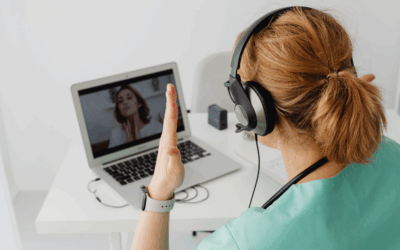Why do you need to learn telemedicine etiquette as a healthcare professional?
In the age of more advanced technology, it’s important for you to know these important telemedicine etiquette. The traditional doctor-patient interaction has undergone a sea of change due to the emergence of telemedicine. With more and more healthcare professionals embracing virtual consultations, learning telemedicine etiquette has become more than a necessity. Why? Because the interaction through a screen differs vastly from the in-person medical encounter.
Thus, a healthcare professional like you need to learn how to navigate the nuances of virtual communication. For instance, this includes audio and video quality, etiquette, platform selection, and how to foster empathy in virtual consultations. By learning these essential skills, you can ensure patient comfort and satisfaction while providing quality healthcare services. So, learning telemedicine etiquette is not just about etiquette. It’s the cornerstone of providing the highest quality of healthcare in your telemedicine practice.
Importance of telemedicine etiquette to patient Care
The success of your telemedicine practice depends on how you conduct yourself during virtual consultations. Certainly, telemedicine etiquette is vital for improving the overall patient experience and ensuring accurate diagnosis and treatment. Proper etiquette entails setting up a conducive environment, ensuring secure communication between patients and providers, and exhibiting professionalism during consultations. Following these guidelines can enhance patient trust and satisfaction, leading to improved health outcomes and better continuity of care. Therefore, it is crucial for you to keep abreast of telemedicine etiquette practices and implement them in their virtual practice.
Incorporate these telemedicine etiquette in your practice!

1. Set the stage: Prepare your virtual environment.
One of the critical aspects of practicing telemedicine etiquette is creating an appropriate virtual environment. To do this, you need to have a quiet, well-lit area that is solely dedicated to telemedicine consultations. Certainly, this space should be free from distractions and confidential items that may detract from the consultation.
Additionally, it’s essential to ensure that your background appears professional. This could involve opting for a virtual background or tidying up your physical space before the consultation. By creating a professional virtual environment, you set the stage for a productive and respectful telemedicine consultation.

2. Technology is your ally: Test your equipment.
Technical glitches can disrupt sessions and erode patient confidence. To avoid such hiccups, rigorously test your equipment, including your camera, microphone, and internet connection, before every session. Likewise, familiarize yourself with the telemedicine platform you use. Don’t forget to do this telemedicine etiquette to ensure a seamless experience for both you and your patient.

3.Time is precious: Be punctual every session.
Being punctual for every session is not just a matter of courtesy, but it also reflects your level of professionalism. As a healthcare provider, it is your responsibility to value your patient’s time and demonstrate respect by starting appointments on time. Further, punctuality reinforces the notion that their health matters to you, and you are committed to their care. Therefore, it is essential to adhere to this telemedicine etiquette by respecting schedules and being punctual.

4. A clear introduction: Begin on the right note.
Each telemedicine session should commence with a clear and professional introduction. With this, confirm the patient’s identity, state your name and role, and briefly outline the purpose of the consultation. This not only lays the foundation for trust but also offers clarity to the patient.

5. Active listening: Truly hear your patient.
Active listening is at the core of effective telemedicine etiquette. So, dedicate your complete attention to the patient’s concerns and avoid interrupting. Use verbal cues like “I understand” or “Please continue” to signal your engagement in the conversation.

6. Connect through the camera: Maintain eye contact.
Sustaining eye contact during telemedicine consultations can be challenging, but it’s vital. When speaking, look directly into the camera to create a sense of connection and engagement. Do this similar to how you would maintain eye contact during an in-person appointment.

7. Privacy matters: Safeguard confidentiality.
It is essential to take the necessary measures to safeguard privacy. Accordingly, make sure that the telemedicine platform you use is HIPAA compliant. Moreover, it must be equipped with the necessary security measures to keep sensitive information secure.
It is also equally crucial to adhere to telemedicine etiquette, such as conducting consultations in a private setting. Additionally, make sure to minimize background noise, and confirm patient identity. By prioritizing privacy and modeling telemedicine etiquette, healthcare professionals uphold the highest standards of care and respect for their patients.

8. Promote dialogue: Encourage two-way communication.
One of the important telemedicine etiquette is encouraging two-way communication. Indeed, it’s crucial to promote open dialogue with patients and invite questions. This is to ensure providers have a complete understanding of their patients’ needs. By all means, utilizing open-ended questions can help gather comprehensive information. Additionally, when you involve patients in decisions about their care, it strengthens the patient-provider relationship.
Following telemedicine etiquette may seem simple, but it is crucial to ensure a meaningful conversation for the patient. Overall, actively promoting two-way communication can increase patient satisfaction while providing effective care.

9. Care Beyond the Screen: Show empathy and compassion.
Effective communication through the screen relies on creating an environment of trust, empathy, and compassion. When patients are confronted with anxiety and uncertainty, it is your responsibility to demonstrate understanding and offer support. Practicing telemedicine etiquette means taking a genuine interest in the emotional state of patients. Also, acknowledge their struggles and provide reassurance in a professional yet empathetic manner. By showing empathy and compassion beyond the screen, you can create a space where patients feel heard and cared for.
Level up your Telemedicine Practice with our Virtual Medical Assistants!
It’s essential to ensure that your telemedicine practice is efficient, streamlined, and patient-friendly. That’s where our Virtual Medical Assistants (VMAs) come in! Our Virtual Medical Assistants serve as the perfect complement to your telemedicine practice. Truly, they enhance productivity while also providing a personalized and seamless experience for both clinicians and patients. They are specifically trained to help with various administrative and clinical tasks. By hiring our Virtual Medical Assistants, you can level up your practice while also improving healthcare outcomes for your patients. See the results for yourself—book a quick discovery call with us!








